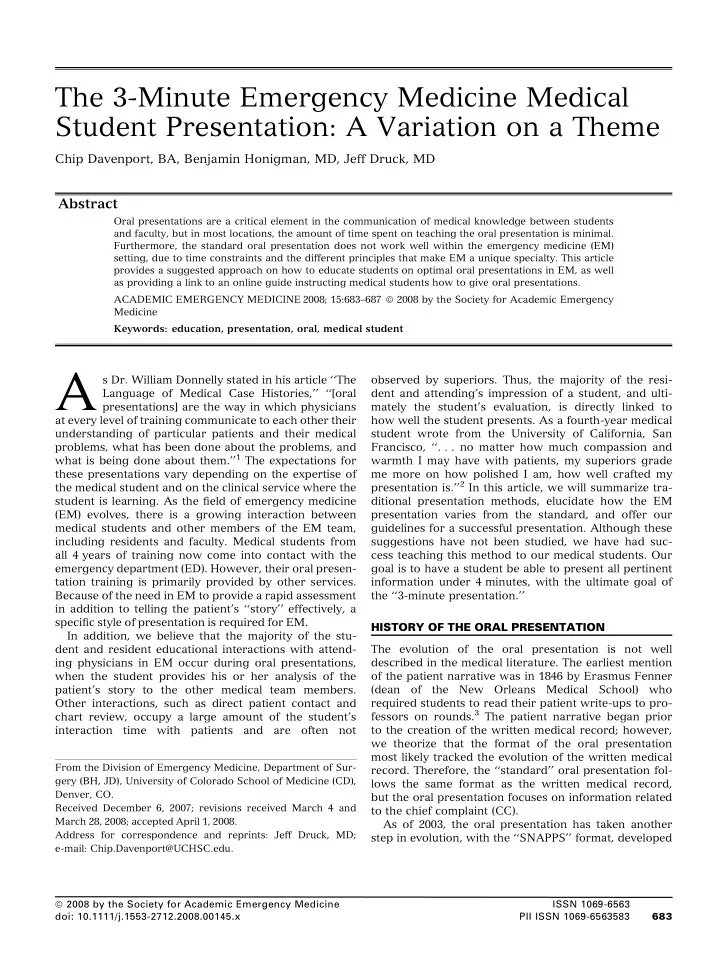

The 3-Minute Emergency Medicine Medical Student Presentation: A Variation on a Theme Chip Davenport, BA, Benjamin Honigman, MD, Jeff Druck, MD Abstract Oral presentations are a critical element in the communication of medical knowledge between students and faculty, but in most locations, the amount of time spent on teaching the oral presentation is minimal. Furthermore, the standard oral presentation does not work well within the emergency medicine (EM) setting, due to time constraints and the different principles that make EM a unique specialty. This article provides a suggested approach on how to educate students on optimal oral presentations in EM, as well as providing a link to an online guide instructing medical students how to give oral presentations. ACADEMIC EMERGENCY MEDICINE 2008; 15:683–687 ª 2008 by the Society for Academic Emergency Medicine Keywords: education, presentation, oral, medical student A s Dr. William Donnelly stated in his article ‘‘The observed by superiors. Thus, the majority of the resi- Language of Medical Case Histories,’’ ‘‘[oral dent and attending’s impression of a student, and ulti- presentations] are the way in which physicians mately the student’s evaluation, is directly linked to at every level of training communicate to each other their how well the student presents. As a fourth-year medical understanding of particular patients and their medical student wrote from the University of California, San problems, what has been done about the problems, and Francisco, ‘‘. . . no matter how much compassion and what is being done about them.’’ 1 The expectations for warmth I may have with patients, my superiors grade these presentations vary depending on the expertise of me more on how polished I am, how well crafted my presentation is.’’ 2 In this article, we will summarize tra- the medical student and on the clinical service where the student is learning. As the field of emergency medicine ditional presentation methods, elucidate how the EM (EM) evolves, there is a growing interaction between presentation varies from the standard, and offer our medical students and other members of the EM team, guidelines for a successful presentation. Although these including residents and faculty. Medical students from suggestions have not been studied, we have had suc- all 4 years of training now come into contact with the cess teaching this method to our medical students. Our emergency department (ED). However, their oral presen- goal is to have a student be able to present all pertinent tation training is primarily provided by other services. information under 4 minutes, with the ultimate goal of Because of the need in EM to provide a rapid assessment the ‘‘3-minute presentation.’’ in addition to telling the patient’s ‘‘story’’ effectively, a specific style of presentation is required for EM. HISTORY OF THE ORAL PRESENTATION In addition, we believe that the majority of the stu- dent and resident educational interactions with attend- The evolution of the oral presentation is not well ing physicians in EM occur during oral presentations, described in the medical literature. The earliest mention when the student provides his or her analysis of the of the patient narrative was in 1846 by Erasmus Fenner (dean of the New Orleans Medical School) who patient’s story to the other medical team members. required students to read their patient write-ups to pro- Other interactions, such as direct patient contact and fessors on rounds. 3 The patient narrative began prior chart review, occupy a large amount of the student’s to the creation of the written medical record; however, interaction time with patients and are often not we theorize that the format of the oral presentation most likely tracked the evolution of the written medical From the Division of Emergency Medicine, Department of Sur- record. Therefore, the ‘‘standard’’ oral presentation fol- gery (BH, JD), University of Colorado School of Medicine (CD), lows the same format as the written medical record, Denver, CO. but the oral presentation focuses on information related Received December 6, 2007; revisions received March 4 and to the chief complaint (CC). March 28, 2008; accepted April 1, 2008. As of 2003, the oral presentation has taken another Address for correspondence and reprints: Jeff Druck, MD; step in evolution, with the ‘‘SNAPPS’’ format, developed e-mail: Chip.Davenport@UCHSC.edu. ª 2008 by the Society for Academic Emergency Medicine ISSN 1069-6563 doi: 10.1111/j.1553-2712.2008.00145.x PII ISSN 1069-6563583 683
Recommend
More recommend